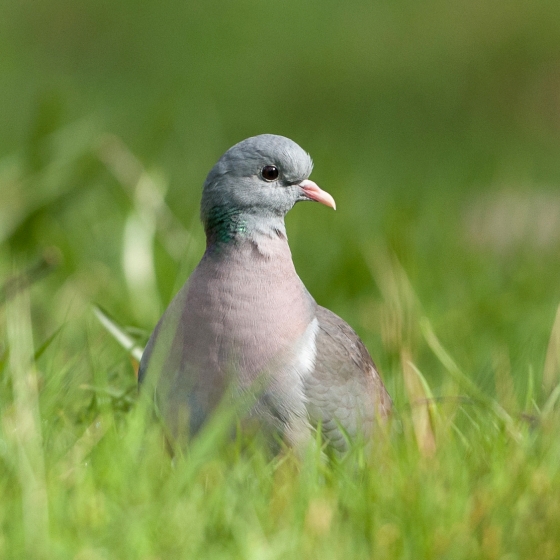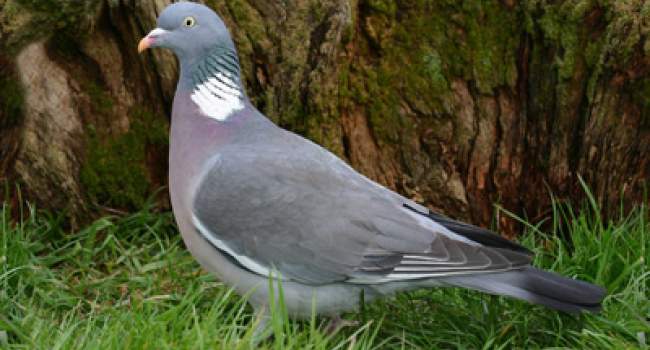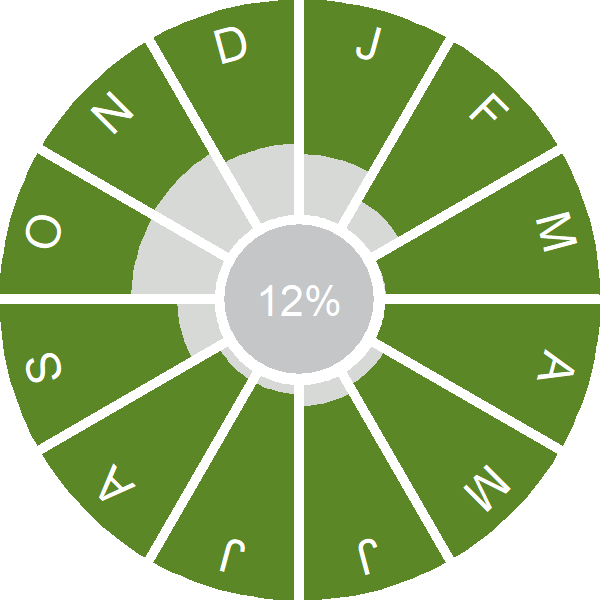Stock Dove
Columba oenas (Linnaeus, 1758)
SD
 STODO
STODO  6680
6680

Family: Columbiformes > Columbidae

The Stock Dove is an arguably underrated bird, despite being a neat and rather pretty species. Smaller than the similar-looking Woodpigeon, and lacking white in the wing, the species is often overlooked.
The Stock Dove boasts a fine blue-grey sheen to its plumage. Two neat black lines on the closed wing, and dark wing edges in flight help to distinguish it from its cousin, the Woodpigeon. Stock Doves enjoy a mixture of farmland for feeding, and woodland where they nest in holes in large old trees.
The Stock Dove is widespread across England, Wales, southern Scotland and eastern Ireland. Bird Atlas 2007-11 data show that there has been range contraction in the north and west of Britain & Ireland over the last few decades, but this has been offset by increases in breeding density in the east.
Exploring the trends for Stock Dove
Our Trends Explorer will also give you the latest insight into how the UK's Stock Dove population is changing.
trends explorerIdentification
Stock Dove identification is often straightforward. The following article may help when identifying Stock Dove.
Identifying Pigeons

Not all pigeons are Woodpigeons - honest! Stock Dove is a very common species, but can you tell it apart from the ubiquitous Woodpigeon? Let us help you tell these two species apart - and make sure you don't confuse them with Feral Pigeon / Rock Dove.
SONGS AND CALLS
Listen to example recordings of the main vocalisations of Stock Dove, provided by xeno-canto contributors.
Other
Call
Song
Develop your bird ID skills with our training courses
Our interactive online courses are a great way to develop your bird identification skills, whether you're new to the hobby or a competent birder looking to hone your abilities.
Browse training coursesStatus and Trends
Population size and trends and patterns of distribution based on BTO surveys and atlases with data collected by BTO volunteers.
CONSERVATION STATUS
This species can be found on the following statutory and conservation listings and schedules.
POPULATION CHANGE
Following release from the lethal and sublethal effects of the organochlorine seed-dressings used in the 1950s and early 1960s, Stock Dove populations have increased very substantially (O'Connor & Mead 1984). Numbers appeared to level off in the early 1980s, but the trend has been generally upward since the 1990s except for a sharp drop in numbers early in the current century. The BBS map of change in relative density between 1994-96 and 2007-09 indicates that increase has been strongest in western and eastern Britain, with decreases in midland regions. An apparent initial increase in nest failure rates at the egg stage, now reversed, was not detectable in farmland habitats alone (Siriwardena et al. 2000b). Overall, nest failure rates have fallen substantially since the 1980s and there has been a major increase in the number of fledglings raised per breeding attempt. There has been an increase across Europe since 1980 (PECBMS: PECBMS 2020a>).
| UK breeding population |
+46% increase (1995–2022) 
|
Exploring the trends for Stock Dove
Our Trends Explorer will also give you the latest insight into how the UK's Stock Dove population is changing.
trends explorerDISTRIBUTION
Stock Doves are distributed widely across most of England in winter and summer, but are absent in both seasons from most of northwest Scotland and from northern and western Ireland. Other gaps include the uplands of northwest Wales and southern Scotland. Highest densities occur around low-altitude alluvial arable farmland and open woodland, particularly throughout much of lowland England.
Occupied 10-km squares in UK
| No. occupied in breeding season | 1966 |
| % occupied in breeding season | 65 |
| No. occupied in winter | 1905 |
| % occupied in winter | 63 |
European Distribution Map
European Breeding Bird Atlas 2
Breeding Season Habitats
| Most frequent in |
Arable Farmland 
|
| Also common in | Villages, Deciduous Wood |
Relative frequency by habitat
Relative occurrence in different habitat types during the breeding season.

DISTRIBUTION CHANGE
Range changes in Britain are small, whereas in Ireland Stock Doves have undergone a considerable and continuous range contraction over the last 40 years, shrinking into the southeast.
Change in occupied 10-km squares in the UK
| % change in range in breeding season (1968–72 to 2008–11) | -4.4% |
| % change in range in winter (1981–84 to 2007–11) | +11.1% |
SEASONALITY
Stock Doves are recorded throughout the year, seen on up to 10% of complete lists in spring and summer.

Movement
Information about movement and migration based on online bird portals (e.g. BirdTrack), Ringing schemes and tracking studies.
RINGING RECOVERIES
View a summary of recoveries in the Online Ringing Report.
Foreign locations of birds ringed or recovered in Britain & Ireland

Biology
Lifecycle and body size information about Stock Dove, including statistics on nesting, eggs and lifespan based on BTO ringing and nest recording data.
PRODUCTIVITY & NESTING
Exploring the trends for Stock Dove
Our Trends Explorer will also give you the latest insight into how the UK's Stock Dove population is changing.
trends explorerSURVIVAL & LONGEVITY
View number ringed each year in the Online Ringing Report
Maximum Age from Ringing 
|
9 years 2 months 12 days (set in 1962) 
|
Typical Lifespan 
|
3 years with breeding typically at 1 year |
Adult Survival 
|
0.55  
|
Juvenile Survival 
|
0.4 (in first year) 
|
Exploring the trends for Stock Dove
Our Trends Explorer will also give you the latest insight into how the UK's Stock Dove population is changing.
trends explorerBIOMETRICS
Wing Length 
|
Adults | 222.4±8.4 | Range 210–234mm, N=316 |
| Juveniles | 210.7±9.2 | Range 192-223mm, N=38 | |
| Males | 225±6.3 | Range 216–236mm, N=45 | |
| Females | 224.4±10.6 | Range 210–235mm, N=73 |
Body Weight 
|
Adults | 326±40.8 | Range 245–387g, N=141 |
| Males | 336±36.8 | Range 274–400g, N=27 | |
| Females | 329±37.1 | Range 280–390g, N=51 |
Feather measurements and photos on featherbase 
CODES & CLASSIFICATION
Ring size 
|
E |
Field Codes 
|
2-letter: SD | 5-letter code: STODO | Euring: 6680 |
For information in another language (where available) click on a linked name
Research
Interpretation and scientific publications about Stock Dove from BTO scientists.
CAUSES AND SOLUTIONS
Causes of change
The increase since the mid 1960s may be due to two phases: an initial recovery from the high mortality caused by organochlorines, followed by increased breeding performance.
Further information on causes of change
Stock Dove is a rare example of a farmland species in long-term increase. Its increase since the mid 1960s may fall into two phases: an initial recovery from the use of organochlorines, followed by an increase in breeding performance. It is not known why breeding should have become more productive. Overall, nest failure rates have fallen substantially since the 1980s and there has been a major increase in fledglings raised per breeding attempt.
A study based on nest record cards showed that egg-stage daily failure rate differed according to farm type between 1962-75 and 1976-95: breeding performance decreased on grazing farms and increased in arable farms, but did not differ in other farm types, suggesting that different environmental factors were acting across farm types (Siriwardena et al. 2000b).
Change from hunting quarry to protected status since 1982 has not affected the species' survival rates or population size (Aebischer 1995).
Information about conservation actions
The population of the Stock Dove is currently increasing in the UK (following a large population decline as a result of widespread organochlorine usage (O'Connor & Mead 1984), and hence specific conservation action is not currently required. It is not clear why this species is increasing in contrast to many other farmland birds, although it is not restricted to farmland and also breeds in woodland and urban areas. Conservation actions targeted at declining farmland bird species which increase the availability of seeds in winter may also benefit this species.
Links to more studies from ConservationEvidence.com
- The incidence of the parasitic disease trichomoniasis and its treatment in reintroduced and wild pink pigeons Columba mayeri
- Trial of a new bait station design to improve the efficiency of rat Rattus control in forest at Black River Gorges National Park, Mauritius
- Restoring avian island endemics: use of supplementary food by the endangered pink pigeon (Columba mayeri)
Read more studies about Stock Dove on Conservation Evidence >
Would you like to search for another species?












Share this page